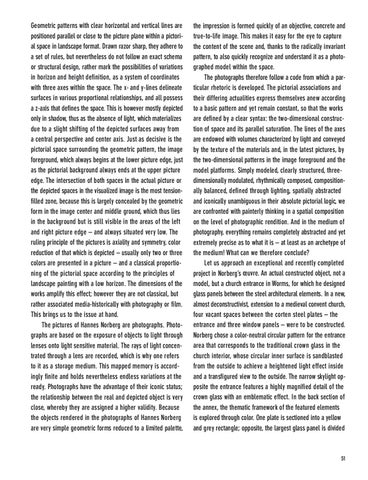Geometric patterns with clear horizontal and vertical lines are positioned parallel or close to the picture plane within a pictorial space in landscape format. Drawn razor sharp, they adhere to a set of rules, but nevertheless do not follow an exact schema or structural design, rather mark the possibilities of variations in horizon and height definition, as a system of coordinates with three axes within the space. The x- and y-lines delineate surfaces in various proportional relationships, and all possess a z-axis that defines the space. This is however mostly depicted only in shadow, thus as the absence of light, which materializes due to a slight shifting of the depicted surfaces away from a central perspective and center axis. Just as decisive is the pictorial space surrounding the geometric pattern, the image foreground, which always begins at the lower picture edge, just as the pictorial background always ends at the upper picture edge. The intersection of both spaces in the actual picture or the depicted spaces in the visualized image is the most tensionfilled zone, because this is largely concealed by the geometric form in the image center and middle ground, which thus lies in the background but is still visible in the areas of the left and right picture edge – and always situated very low. The ruling principle of the pictures is axiality and symmetry, color reduction of that which is depicted – usually only two or three colors are presented in a picture – and a classical proportioning of the pictorial space according to the principles of landscape painting with a low horizon. The dimensions of the works amplify this effect; however they are not classical, but rather associated media-historically with photography or film. This brings us to the issue at hand. The pictures of Hannes Norberg are photographs. Photographs are based on the exposure of objects to light through lenses onto light sensitive material. The rays of light concentrated through a lens are recorded, which is why one refers to it as a storage medium. This mapped memory is accordingly finite and holds nevertheless endless variations at the ready. Photographs have the advantage of their iconic status; the relationship between the real and depicted object is very close, whereby they are assigned a higher validity. Because the objects rendered in the photographs of Hannes Norberg are very simple geometric forms reduced to a limited palette,
the impression is formed quickly of an objective, concrete and true-to-life image. This makes it easy for the eye to capture the content of the scene and, thanks to the radically invariant pattern, to also quickly recognize and understand it as a photographed model within the space. The photographs therefore follow a code from which a particular rhetoric is developed. The pictorial associations and their differing actualities express themselves anew according to a basic pattern and yet remain constant, so that the works are defined by a clear syntax: the two-dimensional construction of space and its parallel saturation. The lines of the axes are endowed with volumes characterized by light and conveyed by the texture of the materials and, in the latest pictures, by the two-dimensional patterns in the image foreground and the model platforms. Simply modeled, clearly structured, threedimensionally modulated, rhythmically composed, compositionally balanced, defined through lighting, spatially abstracted and iconically unambiguous in their absolute pictorial logic, we are confronted with painterly thinking in a spatial composition on the level of photographic rendition. And in the medium of photography, everything remains completely abstracted and yet extremely precise as to what it is – at least as an archetype of the medium! What can we therefore conclude? Let us approach an exceptional and recently completed project in Norberg’s œuvre. An actual constructed object, not a model, but a church entrance in Worms, for which he designed glass panels between the steel architectural elements. In a new, almost deconstructivist, extension to a medieval convent church, four vacant spaces between the corten steel plates – the entrance and three window panels – were to be constructed. Norberg chose a color-neutral circular pattern for the entrance area that corresponds to the traditional crown glass in the church interior, whose circular inner surface is sandblasted from the outside to achieve a heightened light effect inside and a transfigured view to the outside. The narrow skylight opposite the entrance features a highly magnified detail of the crown glass with an emblematic effect. In the back section of the annex, the thematic framework of the featured elements is explored through color. One plate is sectioned into a yellow and grey rectangle; opposite, the largest glass panel is divided
51
